Key takeaways:
- Community involvement and ownership are vital for the success and sustainability of water projects, enhancing engagement and trust among residents.
- Access to clean drinking water significantly impacts health, economic stability, education, and equality, making it a fundamental human necessity.
- Ongoing evaluation and adaptive strategies, including training, community feedback, and understanding local rhythms, are crucial for project effectiveness and addressing unforeseen challenges.
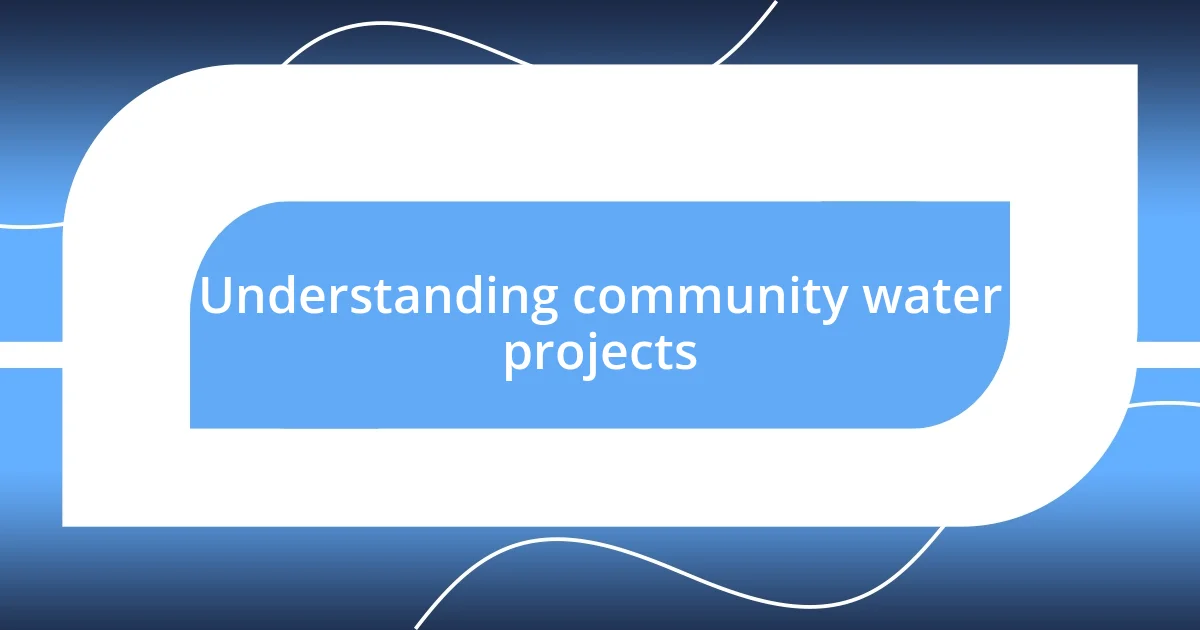
Understanding community water projects
Community water projects are essential initiatives focused on improving access to clean and safe water for local populations. I vividly recall a small village I visited where residents relied on a stagnant pond for drinking water. They shared heart-wrenching stories about waterborne diseases that plagued their community, which made me realize how crucial these projects are in transforming lives.
What really struck me was the role of local involvement in these projects. When community members are actively engaged, they not only contribute valuable insights but also foster a sense of ownership. Have you ever seen firsthand how a group of people can come together to solve a problem? I certainly have. I watched as villagers constructed a rainwater harvesting system, and the pride they felt in that achievement was palpable. It was a powerful reminder of the impact community-driven efforts can have on both the environment and the people they serve.
Understanding the intricacies of community water projects requires acknowledging the varied socio-economic backgrounds of participants. These projects often require not just technical knowledge but also emotional intelligence to navigate the diverse needs and fears within a community. Have you ever considered how feelings of trust and cooperation can lead to successful implementation? Based on what I’ve observed, forming relationships among community members is just as important as the engineering aspects of the project.
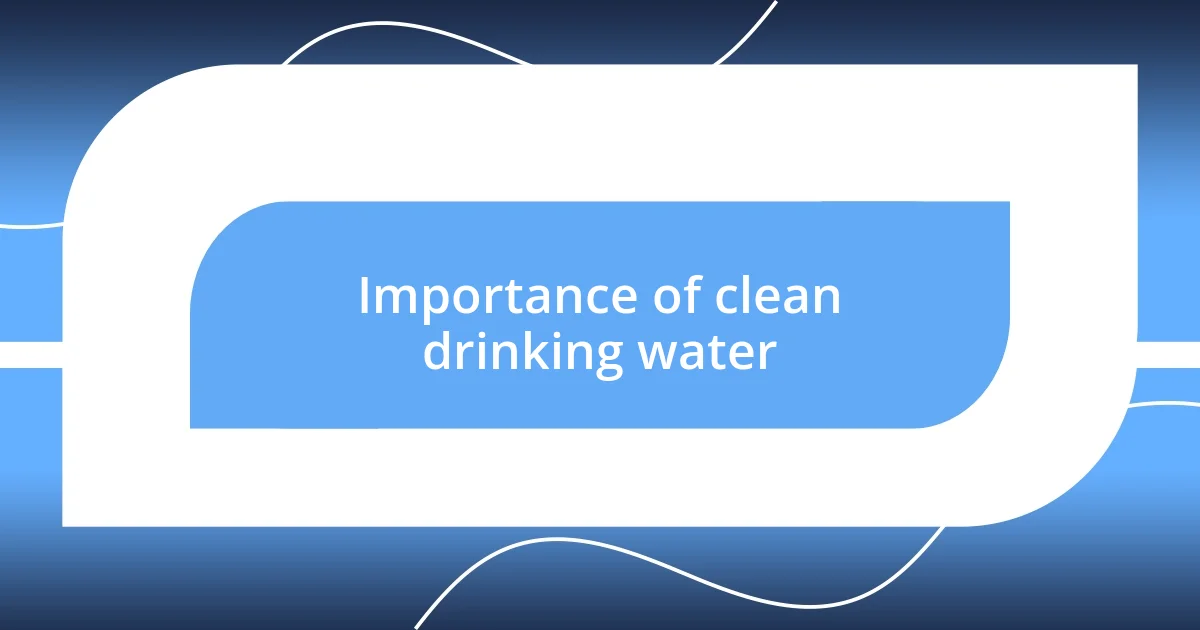
Importance of clean drinking water
Clean drinking water is not just a luxury; it’s a fundamental human need. During my travels, I often found myself pondering the privilege I have in accessing safe water whenever I want. I can vividly remember visiting a region where families used to embark on treacherous journeys just to collect water—only to discover that it was tainted. This stark contrast fueled my understanding of why clean drinking water should be prioritized. Without it, we face health risks, economic burdens, and a diminished quality of life.
- Access to clean water reduces the prevalence of waterborne diseases, protecting lives.
- Safe drinking water fosters economic stability by minimizing healthcare costs and lost productivity.
- Clean water impacts education; children can attend school regularly instead of fetching water.
- It promotes equality, ensuring everyone, regardless of background, has a fair chance at a healthy life.
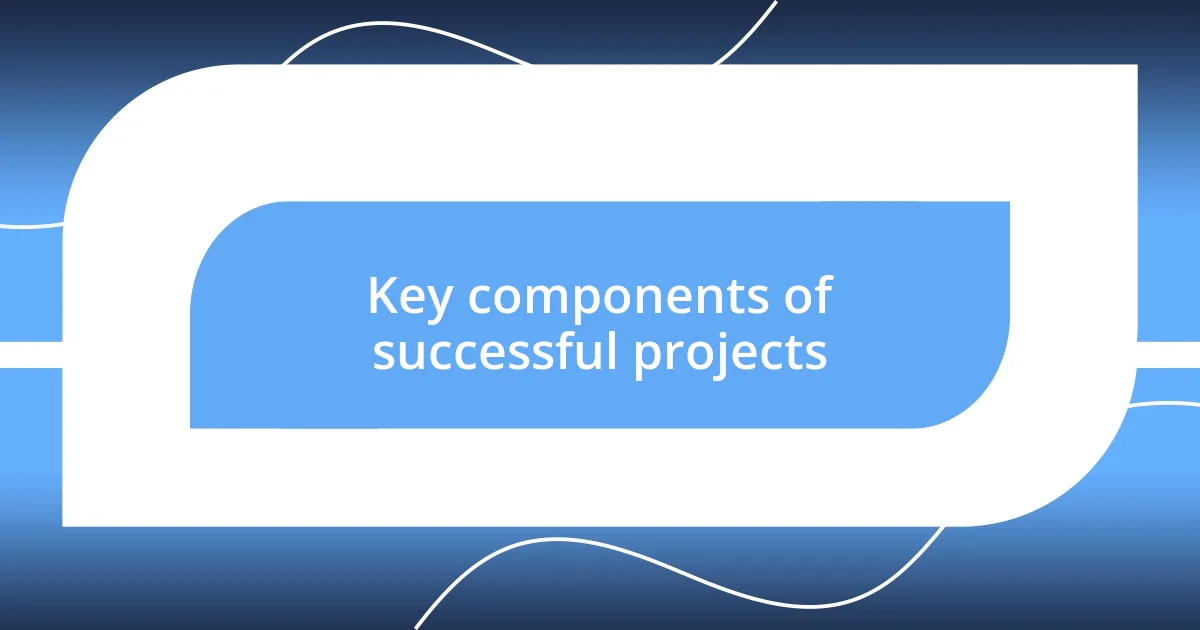
Key components of successful projects
Successful community water projects hinge on several key components that, from my experience, can significantly dictate their impact and sustainability. First and foremost, collaboration is crucial. I remember attending a project evaluation meeting where diverse stakeholders—local leaders, engineers, and residents—shared their perspectives openly. The synergy in that room was palpable. When everyone is on the same page, you’re not just building infrastructure; you’re creating a sense of belonging and shared purpose that fosters long-term success.
Another vital component is knowledge transfer. It’s essential to ensure that the community understands how to maintain the systems in place. I once observed a training session where local volunteers learned how to monitor water quality. Their enthusiasm was invigorating! Having the skills to manage these resources ensures that even after the project team leaves, the community remains empowered and capable of sustaining the benefits.
Finally, monitoring and evaluation can’t be overlooked. Reflecting on my experiences with various projects, I’ve seen how revisiting goals ensures that objectives remain aligned with community needs. For example, in one project, regular surveys revealed changing water quality concerns, prompting timely interventions. This adaptability not only solved immediate issues but also nurtured trust within the community, showcasing that their voices matter.
| Component | Description |
|---|---|
| Collaboration | Engaging all stakeholders fosters unity and shared responsibility. |
| Knowledge Transfer | Training community members ensures sustainability and empowers locals. |
| Monitoring and Evaluation | Regular assessments help adapt projects to evolving needs. |
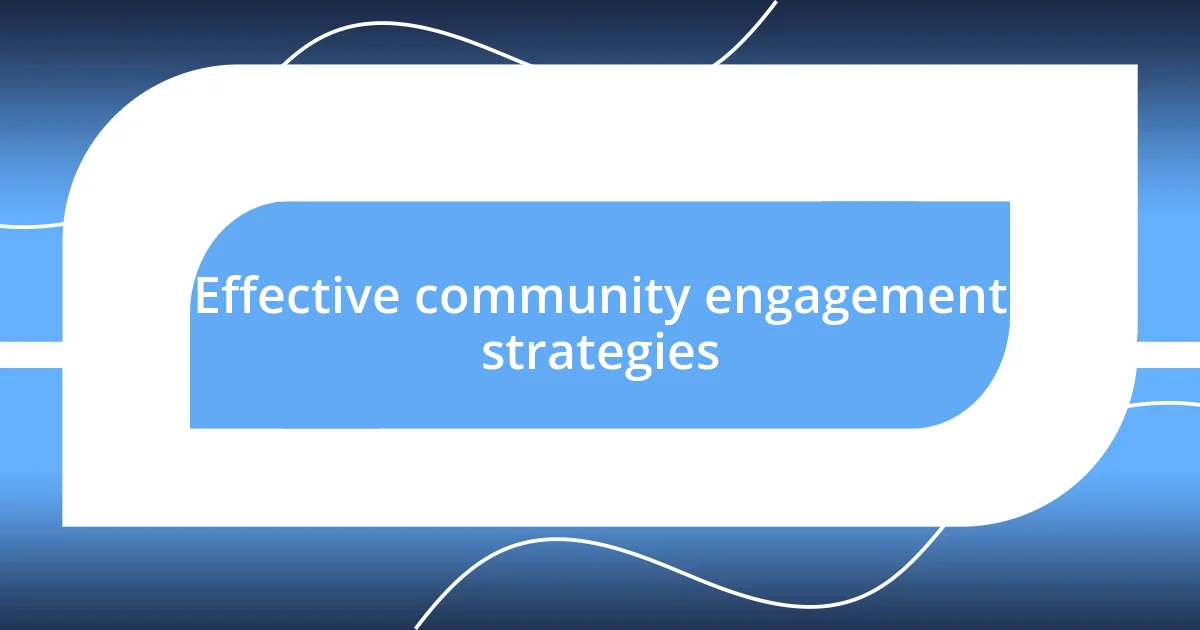
Effective community engagement strategies
Engaging a community effectively requires genuine relationship-building. I remember working on a project where we hosted informal coffee mornings. These casual events turned into safe spaces for residents to voice their concerns. By simply listening and allowing them to share their thoughts, we built trust. Have you ever noticed how open dialogue can change the dynamics in a group? It certainly transformed our project’s atmosphere, turning skeptics into advocates.
Incorporating local culture into outreach strategies is equally important. I once found myself participating in a community festival where we set up a booth to discuss water conservation. The vibrant music and colorful displays pulled people in, making serious conversations about water management feel relevant and connected to their everyday lives. It’s fascinating how culture can elevate engagement—don’t you agree? When people see their values reflected in discussions, they are far more likely to participate meaningfully.
Lastly, flexibility in engagement strategies plays a pivotal role. I encountered a project that initially faced challenges because it didn’t adapt to the community’s unique rhythms. After tweaking meeting times to suit local schedules, attendance surged. So, how do we know when to adjust our approach? Continuous feedback from the community provided invaluable insights. It reminded me that effective engagement isn’t a one-size-fits-all solution; it’s about listening, adjusting, and truly being present in the process.
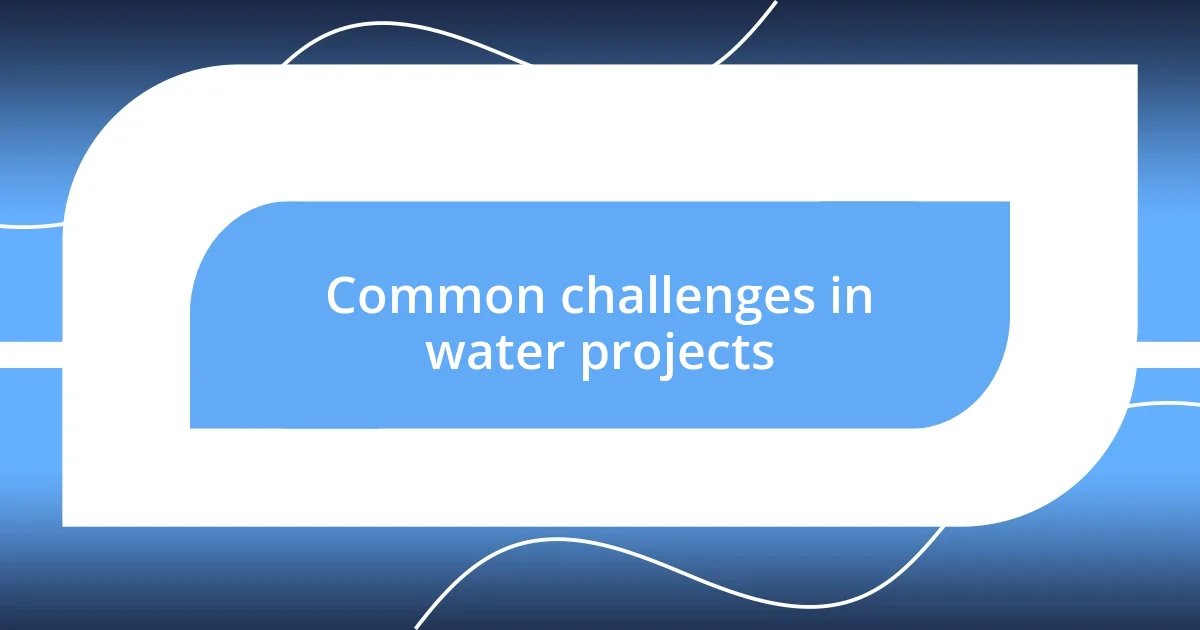
Common challenges in water projects
Common challenges in water projects often stem from a lack of adequate funding and resources. In one project I observed, the excitement to implement a new water filtration system was palpable, yet as costs began to rise, enthusiasm waned. Have you ever felt the sting of ambition meeting harsh reality? It can be disheartening when projects get sidelined because budgets can’t stretch to meet growing needs, leaving communities with unfulfilled promises.
Another significant hurdle is community involvement—or rather, the lack thereof. I recall a project where initial surveys indicated a strong interest in participation, but when it came time for action, only a handful of residents showed up for planning meetings. It made me wonder, why didn’t more people engage? Sometimes, it’s about how projects are framed or perceived. If community members don’t feel a personal stake, they might see initiatives as outsider-driven, which can create a disconnect that’s hard to bridge.
Additionally, maintenance becomes a critical challenge once the project is completed. I’ve seen systems fall into disuse simply because the community hadn’t been equipped with the necessary skills to handle repairs. Do we sometimes underestimate the ongoing commitment required after the initial launch? Without proper training and a clear understanding of ownership, even the best-intentioned projects can falter, leaving communities searching for solutions that were never fully handed to them.
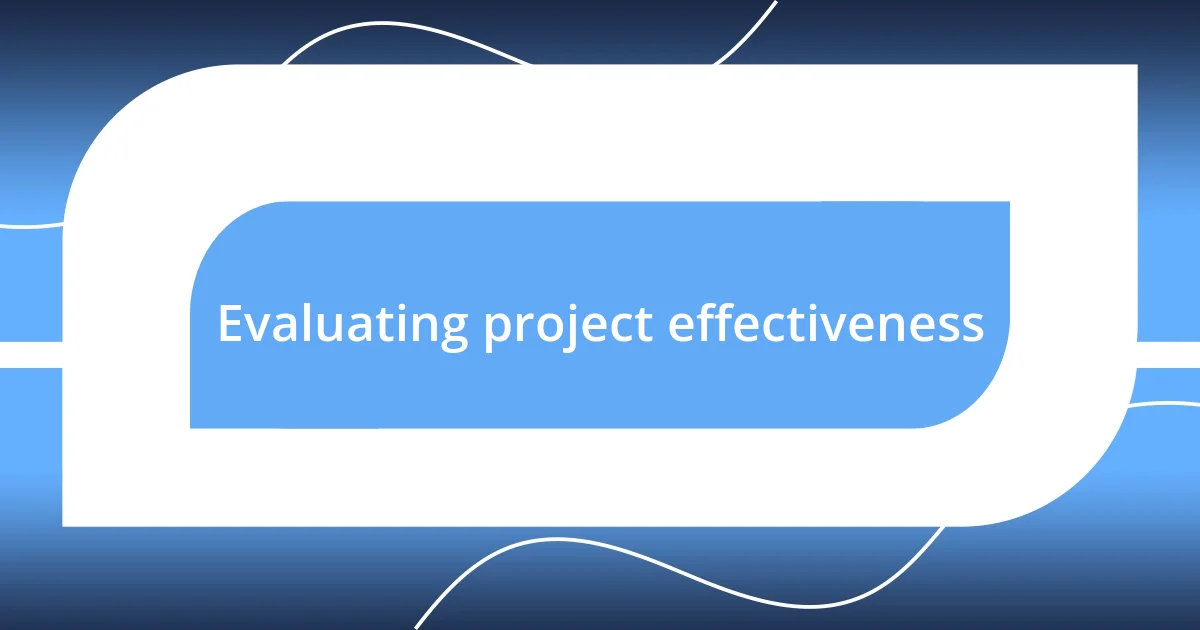
Evaluating project effectiveness
Evaluating the effectiveness of community water projects goes beyond just looking at outputs; it’s about digging deeper into the outcomes that truly impact lives. I recall a project where we installed new wells in a rural area. Initially, we celebrated the increased water access, but it wasn’t until we surveyed residents months later that we learned about the improvements in their health. Seeing families thriving because of better water quality reinforced the idea for me that measuring success requires listening to those we serve. Have you ever found yourself surprised by the ripple effects of a seemingly straightforward initiative?
Engagement metrics can also offer valuable insights into a project’s effectiveness. I vividly remember conducting follow-up workshops after a water management initiative. The attendance and participation levels were eye-opening. At first, I worried that a drop in numbers indicated disinterest. Instead, it revealed that individuals felt empowered enough to manage their responsibilities independently. How often do we underestimate the power of community ownership? By fostering an environment of teamwork, we may find that our projects can flourish in ways we never anticipated.
Finally, it’s essential to incorporate qualitative feedback, not just quantitative data. Feedback sessions often led to discussions that illuminated underlying issues, like distrust toward previous initiatives. I once witnessed a group share their frustrations openly, wishing to influence future projects positively. It made me realize that by creating spaces for honest dialogue, we not only evaluate effectiveness but also lay the groundwork for future improvements. Isn’t it refreshing when community voices feel heard and valued? These insights drive home the importance of a reflective evaluation process in community water projects.












